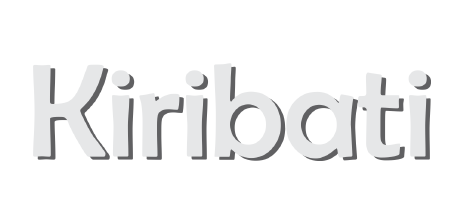
Kiribati, officially known as, the Republic of Kiribati, is an island nation that follows the Presidential Republic of government. The island was called the Gilbert Islands, discovered by Thomas Gilbert and it became a British Protectorate in 1892, captured by the Japanese in 1941. The islands were given complete independence by the U.K in 1979. In terms of land area, the island of Kiribati is the largest in the world. The motto of the island is ‘Te Mauri Te ao Te Tabomoa’, which translates as ‘Health, Peace and Prosperity’. The significance of the flag is that the bird resembles the sea, freedom, power and the island’s ethnic dance styles, the sun resembles the position of the nation at the equator and the ocean resembles the Pacific Ocean.
Kiribati has a group of 33 coral atolls in the Pacific Ocean, out of which 21 are inhabited, and is located in Oceania as well as the International Date Line. Its capital, Tarawa, is just about half way between Australia and Hawaii. Straddling the equator, it lies between 1°25’N latitude and 173° 00’E longitude. Covering a total area of 811 sq. km, it boasts to be the largest land area in the world. It stretches a coastline of 1,143 km, the island is about four times the size of Washington, D.C. The only country in the world that is situated in all the four hemispheres is Kiribati.

The island of Kiribati is mostly a low-lying coral atoll and is surrounded by the extensive reefs. The land’s natural resource is phosphate but all was mined out before its independence. It has thin and calcareous soil, with a low water-holding capacity and low organic matter and nutrients. The only place suitable for agriculture on the land is Banaba. The climate of Kiribati is tropical. It enjoys a pleasant weather from April to October. The western gales causes rains from November to March. The predominant trade winds moderate the temperatures to 30°C. As located near the equator, they are dry and often cause droughts.

Due to high number of atolls and high level of salinization of soil, Kiribati has poor flora. However, there are no endemic species and the existing ones have become extinct due to the human settlements and phosphate mining. The most common wild plants are the coconut and pandanus palms and breadfruit trees. The Chinese cabbage, pumpkin, tomato, watermelon and cucumber are the most cultivated crops. The land has few mammals including the Polynesian, dogs and pigs, the Bokikokiko, etc.

The primary source of food is the fish and other marine resources. Coconut is an important part of the diet and is specially used for the preparation of sweet and vitamin-rich toddy, which is used as children’s drink or as syrup. Rice, flour, canned butter, canned fish, canned meat and other imported items have become an important part of the daily diet. Local foods like crayfish, giant, clam, pig, chicken and giant swamp taro form a centre during the feasts.

Though Kiribati has adopted democracy and egalitarianism, gender discrimination can still be seen in the country. Men are generally involved in fishing, collecting toddy and in heavy construction, whereas women are involved in childcare, cooking, cultivating crops and keeping the house. The common culture of arranged marriage is prevalent in rural areas. Many families have started allowing love marriages. Despite criticised by the churches, the virginity tests are still valued in the country. The families are generally nuclear with the ageing parents and the adoptive kin. The etiquettes of the people are the appropriate places to sit and interact, which is called ‘maneaba’. The taboo is when an individual touches the top of the head. Women are more concerned about modest dressing and cleanliness. The majority of the people are Catholic. The others include Protestants, Seventh-Day Adventist, Bahaí and other members of Church of God and the Church of Latter-Day Saints. The commonly spoken language on the island is Gilbertese and the official language of the people is English.

Kiribati had huge deposits of phosphate but were exhausted at the time of independence in the year 1979. Hence, the main activities are fishing and agriculture. The bulk production and exports includes copra and fish, coconut and seawood. The agricultural products of the country are copra, taro, breadfruit, sweet potatoes, vegetables, etc. Due to the shortage of skilled workers, weak infrastructure and remoteness from the international markets are the barriers for the economic development of the island. The import commodities include foodstuffs, machinery and equipment, manufactured goods and fuel. Tourism, in the recent years, is gaining significance and contributes to the country’s GDP. Kiribati gets financial aid from countries like the European Union, United Kingdom, United States, Japan, Australia, New Zealand, Canada, etc.

G Kowledge of | 0 Comments >>
0 Comments
Leave Comment
Your email address will not be published. Required fields are marked.